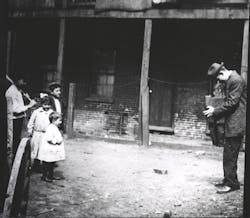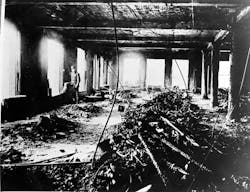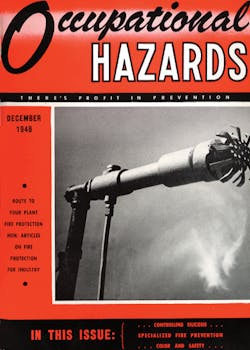The Photographs of Lewis Hine: The Industrial Revolution and Child Laborers [Photo Gallery]
"There is work that profits children, and there is work that brings profit only to employers. The object of employing children is not to train them, but to get high profits from their work." – Lewis Hine, 1908.
The Industrial Age that occurred after the Civil War created a demand for labor and many children were drawn into the labor force. Factory wages were so low that children often had to work to help support their families. According to the National Archives, the number of children under the age of 15 who worked in industrial jobs for wages climbed from 1.5 million in 1890 to 2 million in 1910.
Employers viewed children as a bargain: They worked in unskilled jobs for lower wages than adults, and their small hands made them more adept at handling small parts and tools. The fact that the child workers began to develop serious health problems and developed diseases related to their work environment, such as tuberculosis and bronchitis for those who worked in coal mines or cotton mills was irrelevant to their employers. There were always more children.
Education was seen as a luxury, but one teacher would have a profound impact on our view of child labor. Lewis Hine, was a New York City schoolteacher and photographer, and he believed that a picture could tell a powerful story. He felt so strongly about the abuse of children as workers that he quit his teaching job and became an investigative photographer for the National Child Labor Committee.
Hine believed that if people could see for themselves the abuses and injustice of child labor, they would demand laws to end it. He often tricked his way into factories to take the pictures that factory managers did not want the public to see. He would tell factory owners that he wanted the child laborers in the photos to show the size of the modern machinery.
He was careful to document every photograph with precise facts and figures, interviewing the children and scribbling notes with his hand hidden inside his pocket. Because he often tricked owners and supervisors to allow him to take his photographs, he believed that he had to be “double-sure that my photo data was 100 percent pure – no retouching or fakery of any kind."
The National Child Labor Committee was formed in 1904, with a goal to end child labor. The organization received a charter from Congress in 1907. It hired teams of investigators to gather evidence of children working in harsh conditions and then organized exhibitions with photographs and statistics to dramatize the plight of these children. The Children's Bureau became a federal information clearinghouse in 1912 and i 1913, the Children's Bureau was transferred to the Department of Labor.
In 1916, Congress passed the Keating-Owens Act that established child labor standards such as a minimum age of 14 for workers in manufacturing and 16 for workers in mining; a maximum workday of 8 hours; prohibition of night work for workers under age 16; and a documentary proof of age. The law was later ruled unconstitutional on the ground that congressional power to regulate interstate commerce did not extend to the conditions of labor. Reformers did succeed in forcing legislation at the state level banning child labor and setting maximum hours and by 1920, the number of child laborers was cut to nearly half of what it had been in 1910.
Lewis Hine died in poverty but his photos live on as a reminder of the horrors of child labor and, frankly, the dangers to all workers found in Industrial Age workplaces.
These are just a few of his photographs, along with his original captions. All photos and captions are by Lewis Hine from the Records of the Children’s Bureau, housed within The National Archives.
Related Photo Galleries:
About the Author

Sandy Smith
Sandy Smith is the former content director of EHS Today, and is currently the EHSQ content & community lead at Intelex Technologies Inc. She has written about occupational safety and health and environmental issues since 1990.


